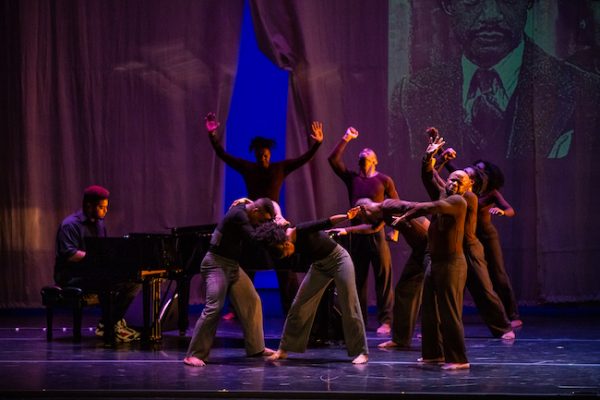Dance Review: Camille A. Brown & Dancers — Ease, Grace, and Jubilation
By Jessica Lockhart
It was a treat to see Camille A. Brown & Dancers inhabit (and elaborate on) a number of different African American dance traditions with such winning ease and grace.
Camille A. Brown & Dancers, presented by Celebrity Series of Boston at the Boch Center Shubert Theatre, Boston, MA, March 7 and 8.

Timothy Edwards and Maleek Washington performing ink with the Camille A. Brown & Dancers at the Boch Center Shubert Theatre. Photo: Robert Torres.
As audience members took their seats, they saw that the stage was filled with giant projected images of young dancers, 75 students from local youth organizations and dance studios. They had been invited to a workshop earlier in the week presented by Camille A. Brown & Company at Roxbury’s Hibernian Hall. The photos captured the students’ excitement and fun as they learned some of the choreography to one of the dances that would be performed. Camille A. Brown hopes that, by helping African Americans appreciate their bodies, they will understand their history as well as where black movement began. These students learned Juba (a precursor to the tap dance), which was developed by African Americans on plantations during the era of slavery.
I first saw Camille A. Brown & Dancers in 2014 at the Bates Dance Festival in Maine. I was impressed with her skill at presenting difficult political/cultural subject material in a nonthreatening way. I saw a full-length performance of Mr. TOL E. RAncE, a searing deconstruction of minstrel shows. At the Shubert performance, we saw an excerpt from that piece, “Act 1: What it is.” Eight performers filled the stage. They began by embracing a slow, contemplative movement; their spines were rounded downward. These were bodies that read as depressed and repressed. They then made exaggerated gestures, with wildly forced happy faces. Following that, the speed of the dance picked up; the performers became fiercely energetic, dancing up a storm, generating nonstop exhilaration through big movements and wowie tricks. Scott Patterson, performing live on the piano, made us feel like we were in an old-timey dance hall.
In this dance, Brown drew on the genre of the minstrel show, but she also included allusions to black performers from television, from Amos ‘n’ Andy and The Cosby Show to The Fresh Prince of Bel Air. All were seen as part of a dominate culture that portrays African Americans artists as trapped in a “blackface” role that they are not able to escape. Minstrel shows exploited black stereotypes, projecting images of uneducated, lazy, yet ever-cheerful people who served as the brunt of the jokes. Television performers seemed to have continued the demeaning tradition.

Camille A. Brown & Dancers at the Shubert Theatre performing an excerpt from Mr.-TOL E. RAncE. Photo: Robert Torres.
Next on the program was an excerpt from Black Girl: Linguistic Play. This playful duet, performed by Brown and Catherine Foster, was joyous, a delightfully stylized look into how two black girlfriends relate to each other. They used their bodies to dramatize an animated give-and-take, an ecstatic call-and-response. Rhythmic stomping and clapping on a raised platform amplified their sounds. Using their sneakers they banged out intricate rhythms that were as nuanced as highly skilled tap dancing. This was the dance, which touches on Juba, ring shout, and double dutch, that the company taught to the 75 kids.
Mr. Tol E. RAncE and Black Girl are the first and second parts of a Camille A. Brown trilogy about identity. The third part, ink, came next. Performers Timothy Edwards and Maleek Washington explored the kind of everyday gestures and postures that young males display on a street corner or a basketball court. How do black men connect with each other? This duet examined the dark side of male friendship and communication. They looked over their shoulders suspiciously; there was no give-and-take. This dance was about males protecting their backs, a striking (and illuminating) contrast to the joy of the female pair.
The final dance of the evening was 2006’s New Second Line. Brown choreographed this piece one year after Hurricane Katrina hit New Orleans. At funerals and weddings, the tradition is for the family and a brass band to parade through the streets; this is referred to as the First Line. The Second Line is made up of people who join the march along the way, eager to celebrate and dance. New Second Line pays homage to the passion and community created by jubilant participation. It was a treat to see Camille Brown & Dancers inhabit (and elaborate on) a number of different African American dance traditions with such winning ease and grace.
Jessica Lockhart is a National Endowment for the Arts Fellow in Dance Criticism and has a BA in Communication from the University of Southern Maine. Lockhart is a Maine Association of Broadcasters award-winning independent journalist. Currently, she also works as program director at WMPG Community radio.

